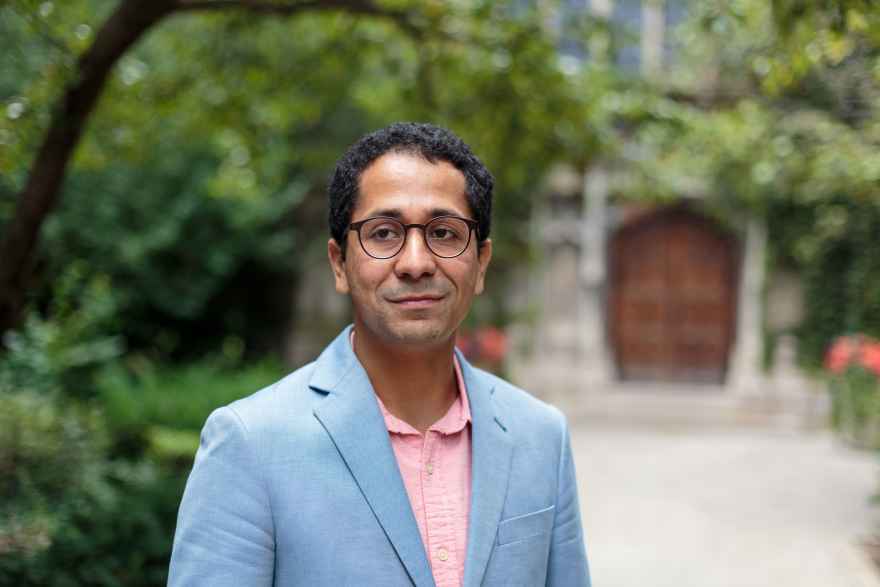Humanities Scholar Edgar Garcia to Receive MLA's William Riley Parker Prize Honorable Mention

Edgar Garcia’s scholarship focuses on cultural practices and literatures of indigenous people in the Americas, which historically have not been considered literature. For his article “Pictography, Law, and Earth: Gerald Vizenor, John Borrows, and Louise Erdrich” published in the March 2019 issue of PMLA, the Modern Language Association’s literary journal, he will receive the William Riley Parker Prize Honorable Mention at the MLA Conference in Seattle on January 11, 2020.
“Edgar Garcia’s brilliant article in PMLA is one piece of his soon-to-be published book Signs of the Americas: A Poetics of Pictography, Hieroglyphs, and Khipu,” said Deborah L. Nelson, the Helen B. and Frank L. Sulzberger Professor and Chair in the Department of English Language and Literature. “Garcia, who is also an award-winning poet, traces the sign-systems of indigenous peoples across the hemispheric Americas not as mere relics of the past but as dynamic, still signifying components of contemporary arts and politics.”
In the PMLA article, , Garcia compellingly argues that the arts and legal thinking of Native Americans through pictographs, petroglyphs, hieroglyphs, and khipu (knot writing) are not dead sign systems but are living and in contemporary use. “Pictographs shift attention from the letter of the law to the spirit of the law and therefore are used by contemporary indigenous scholars of law, such as John Borrows,” he said.
According to the PMLA Selection Committee’s citation, “Edgar Garcia’s interdisciplinary treatment of two underutilized archives—pictographs and indigenous constitutions—offers a keen analysis of the interface of law and literature, particularly in relation to race, nationalism, and decolonization. The breadth of Garcia’s knowledge on these topics is truly impressive, and he synthesizes that knowledge into a compelling, perceptive, and gracefully written essay, a model for interdisciplinary scholarship. Pictographs constitute a highly original object of study, and “Pictography, Law, and Earth: Gerald Vizenor, John Borrows, and Louise Erdrich” is fascinating and persuasively analyzed. Garcia’s pleasure in his topics and the ardor with which he investigates their social implications make for a powerful and illuminating essay.”
The honor for the PMLA article resonates deeply for Garcia because it legitimizes the literary merit of pictographs. “For the MLA to recognize my scholarship has significant meaning for nonalphabetical works and is very important,” said Garcia, the Neubauer Family Assistant Professor in the Department of English Language and Literature at UChicago.
Through his scholarship, Garcia focuses on answering such questions as: How are semiotics and aesthetics an interface for racial and national positionalities? How do the social locations of identity, race, gender, kinship, and ecology change when cast in aesthetic forms found in nonalphabetical signs? How do Puebloan pictographs, Anishinaabe petroglyphs, Mayan hieroglyphs, and Andean khipu express and shape contemporary experiences? He seeks answers to these questions in the context of the literature, law, anthropology, and history in the Americas.
“My peers at the University of Chicago have encouraged me to think more expansively about indigenous law in conversation with poetics and rhetoric—how, for example, indigenous law illuminates 18th century legal problems considered by such Western scholars as Edmund Burke,” said Garcia, who arrived at UChicago in 2015 after completing his PhD at Yale University. “I began to consider my ideas on different scales. For example, how do these signs bear intellectual form as well as content? What is their historical context, and what are their theoretical horizons?”
As the world becomes more enmeshed in digital technology and globalization, people tend to become more closed in, more isolated, which is counterproductive to human flourishing, according to Garcia. He contends that engaging with the humanity of cultural objects can bring us closer together and “reach across cultural divides and not let them destroy us.”
While Garcia was researching sign systems to write Signs of the Americas, he also became intrigued with how to organize and understand different strategies of divining—hepatomancy, astrology, Tarot, chiromancy, sortilege, and political polling—which have become integrated into literary works and life practices in the Americas. Garcia recognized that divining is intrinsically related to the literature of migration. Through a humanistic critique of the theory of probability and a critique of the science of demographics (making human norms out of numbers) that emerges from probabilistic thinking, his next book will discuss how nonprobabilistic forms of risk analysis such as divination entwine with situations of migration—recalling older concepts of fortune and fate.
For now, Garcia expects to continue theorizing on the transdisciplinary noise at the intersection of poetry and anthropology.